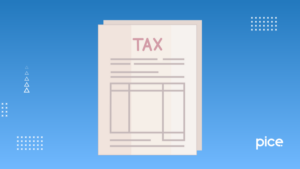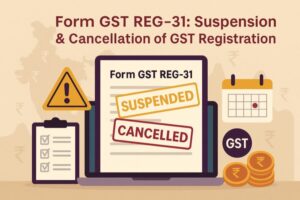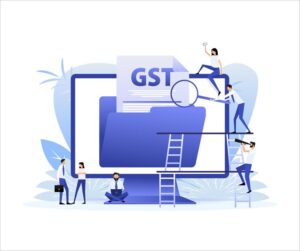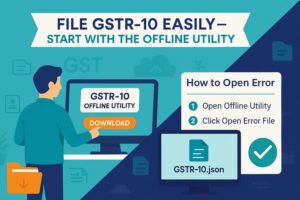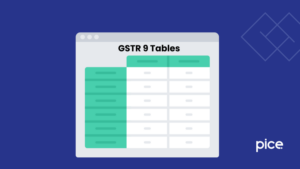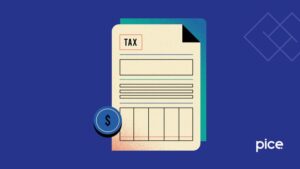What is provisional assessment in GST?
- 15 Aug 24
- 21 mins

What is provisional assessment in GST?
- What Does Assessment under GST Mean?
- What is a provisional assessment under GST?
- What is the liability of the assessee in the event of a 'provisional assessment?
- What are the consequences of the provisional assessment for the final assessment?
- What is the Procedure to be Followed to Get Provisionally Assessed?
- What Shall the Order Issued in FORM GST ASMT-04 Include?
- Assessee's Role in Receipt of the Order in FORM GST ASMT-04
- What is the Time Period for the Finalization of Provisional Assessment in GST?
- Can the Tenure of Finalization of the Provisional Assessment be Extended?
- When will security be released?
- Why is provisional assessment important?
- Conclusion
Key Takeaways
- Ensures Compliance: Helps taxpayers remain compliant by allowing them to pay taxes based on estimated values or rates when precise data is unavailable.
- Facilitates Financial Planning: It enables businesses to manage cash flows effectively by providing an early estimate of tax liabilities.
- Reduces Disputes: Minimizes conflicts between taxpayers and tax authorities by establishing a preliminary tax base for negotiation and adjustment.
- Supports Timely Tax Collection: It assists in the smooth collection of taxes, ensuring that government revenue is not disrupted.
- Aids in Accurate Final Assessments: Provides a foundation for the final tax assessment, ensuring adjustments are made based on more complete and accurate information later.
Assessment under the Goods and Services Tax (GST) framework is a critical aspect that ensures compliance and accurate tax liability. This process helps both the taxpayers and the authorities maintain transparency and regularity in tax administration
What Does Assessment under GST Mean?
Assessment under the Goods and Services Tax (GST) refers to the process by which the tax authorities determine the tax liability of a taxpayer. This includes evaluating the tax returns and related additional documents submitted by taxpayers to ensure that the correct amount of tax is being paid.

The assessment ensures compliance with the tax laws and helps in the accurate collection of GST, which is crucial for the government's revenue system.
There are different types of assessment under GST, including:
- Self-Assessment: Taxpayers calculate their tax liability and pay taxes on their own without any intervention from the tax authorities.
- Provisional Assessment: When taxpayers are unable to determine the value of goods or services or the applicable tax rate, they can request a provisional assessment. This allows them to pay tax on a provisional basis until the correct amount can be determined.
- Scrutiny Assessment: The tax authorities may scrutinize the returns to verify their accuracy and ensure that the correct amount of tax has been paid.
- Summary Assessment: In cases where there is evidence that a delay in assessment would lead to revenue loss, an immediate assessment can be made to safeguard government revenues.
What is a provisional assessment under GST?
A provisional assessment under the Goods and Services Tax (GST) is a mechanism that allows taxpayers to pay tax on a provisional basis when they are unable to determine the tax rate or the taxable value of goods and services. This situation might arise due to uncertainty or ambiguity regarding the applicable tax rate or the assessment of the tax base.
Key Points about Provisional Assessment under GST:
- Application by Taxpayer: The taxpayer must request a provisional assessment when they face uncertainty about determining the exact tax liability. This is typically done by submitting a written application to the concerned GST officer, explaining the reasons for the uncertainty.
- Issuance of Order: Upon receiving the application, the GST officer reviews it and issues an order for provisional tax payment. This order specifies the amount of tax that the taxpayer is expected to pay on a provisional basis.
- Security or Bond: The taxpayer may be required to furnish a bond with or without a security guarantee, ensuring that the difference between the provisionally paid tax and the final tax liability will be paid.
- Adjustment Against Final Assessment: After the provisional assessment, once the correct tax rate or value is determined, a final assessment is conducted. If the provisionally paid tax is less than the actual tax liability, the taxpayer must pay the difference, along with any applicable interest. Conversely, if the provisional tax exceeds the final tax liability, the taxpayer will be entitled to a refund, also subject to applicable interest.
- Finalization Timeframe: The assessment finalization must be finalized within a specified period, typically six months, which can be extended if necessary. This period starts from the date the taxpayer provides all necessary information to the GST officer.
What is the liability of the assessee in the event of a 'provisional assessment?

In the event of a provisional assessment under GST, the assessee (the taxpayer) has several liabilities and responsibilities to ensure compliance with the tax laws.
Here are the key liabilities:
- Payment of Provisional Tax: The assessee's main obligation under the terms of the provisional assessment is to pay the tax amount that the GST officer has determined. This amount is based on the best estimates available at the time and serves as a temporary measure until the final tax liability can be ascertained.
- Furnishing of Security: The assessee might be required to furnish security in the form of a bond or a bank guarantee. This security ensures that the government can recover any shortfall in tax payment once the final assessment is completed. The terms and the amount of security are generally specified by the GST officer in the provisional assessment order.
- Submission of Additional Information: The assessee must provide all necessary documentation and information required for finalizing the assessment. This may include detailed records of business transactions, invoices, and other relevant data that can affect the final tax liability.
- Compliance with Adjustments: Once the final assessment is done, if it is found that the provisional tax paid is less than the actual tax due, the assessee is liable to pay the difference. This amount will also attract interest from the date of underpayment until the date of actual payment. Conversely, if the provisional tax paid is more than the due amount, the assessee is eligible for a refund, which may also include interest.
- Regular Monitoring and Communication: The assessee should regularly monitor the status of the provisional assessment and stay in communication with the tax authorities. Promptly addressing queries and complying with procedural requirements can help in efficient and timely finalization of the assessment.
- Adjusting Provisional Payments: During the period between the provisional and final assessment, if the assessee realizes that the earlier estimates were significantly off, they may need to adjust their provisional payments accordingly. This proactive approach can minimize interest liabilities on underpayments.
What are the consequences of the provisional assessment for the final assessment?
| Consequence Type | Description |
|---|---|
| Basis for Final Assessment | Provisional assessment serves as the preliminary basis for calculating the final tax liabilities. |
| Adjustment of Tax Payments | Differences between the provisional and final tax amounts are adjusted, which might involve additional payments or refunds, including interest. |
| Impact on Cash Flow | Changes in tax liabilities can significantly affect the business's cash flow, depending on whether the provisional tax was overestimated or underestimated. |
| Compliance and Documentation | The accuracy and completeness of documentation provided during provisional assessment impact the ease and outcome of the final assessment. |
| Interest and Penalties | Interest accrues on any underpaid tax from the date it was due until it is paid; penalties may apply for non-compliance. |
| Legal and Administrative Consequences | Severe discrepancies can lead to scrutiny, audits, and potential legal actions by tax authorities. |
| Reputational Impact | Frequent or significant differences between provisional and final assessments may negatively affect the business's reputation with authorities and stakeholders. |
What is the Procedure to be Followed to Get Provisionally Assessed?
The procedure to obtain a provisional assessment under GST involves several steps that a taxpayer must follow to ensure compliance and facilitate the process of determining their tax liabilities. Here’s a breakdown of the procedure:
- Application for Provisional Assessment
The taxpayer must submit a written application to the GST officer in charge of their case. This application should clearly state the reason why they are unable to determine the tax rate or the value of the goods and services.
The application must also specify the details of the uncertain tax liability.
- Submission of Necessary Documents
Along with the application, the taxpayer needs to provide all relevant documents that support their case. This may include invoices, contracts, and other transaction documents that detail the nature of the goods or services involved.
- Furnishing of Security
The taxpayer may be required to furnish a bond, with or without a bank guarantee, as security for any differential amount that may arise between the provisional and final assessment. The GST officer will specify the terms and the amount of the security.
- Issuance of the Provisional Assessment Order
Once the application is reviewed and found satisfactory, the GST officer will issue an order for a provisional assessment. This order will specify the rate or value at which the tax should be paid on a provisional basis.
The order, known as FORM GST ASMT-01, will include all the terms of the provisional assessment, including any security furnished.
- Payment of Tax
Based on the order, the taxpayer must pay the tax at the specified rate or value on a provisional basis.
This payment should be made within the time frame specified in the order to avoid any interest or penalties.
- Final Assessment
The provisional assessment is subject to final adjustment. The taxpayer must continue to provide any additional information required by the GST officer for the final assessment.
Once all necessary data is collected and the actual tax liability is determined, the GST officer will issue a final assessment order (FORM GST ASMT-03).
- Adjustment of Tax Payments
If the provisional tax paid is less than the actual tax liability determined in the final assessment, the taxpayer will need to pay the difference, along with applicable interest.
Conversely, if the provisional tax paid is more than the final tax liability, the taxpayer will be entitled to a refund, also including interest.
- Release of Security
Once the final assessment is completed and any differential dues are settled, the security (if any) provided by the taxpayer will be released.
What Shall the Order Issued in FORM GST ASMT-04 Include?

The order issued in FORM GST ASMT-04 under the Goods and Services Tax (GST) framework is a crucial document related to provisional assessment. After reviewing the taxpayer's application for a provisional assessment, the GST officer issues this form.
Here’s what FORM GST ASMT-04 typically includes:
- Taxpayer Details
Name and address of the taxpayer.
GSTIN (Goods and Services Tax Identification Number) of the taxpayer.
- Order Reference
Unique identification number of the order.
Date of issue of the order.
- Description of Goods or Services
Detailed description of the goods or services involved in the provisional assessment.
Any relevant classification details, such as HSN (Harmonized System of Nomenclature) or SAC (Services Accounting Code) codes.
- Basis of Provisional Assessment
The reasons for the provisional assessment, detailing why the taxpayer could not determine the tax rate or the value.
Any assumptions or estimations made to arrive at the provisional values or gst rates.
- Provisional Tax Rate or Value
The tax rate or value at which the tax is to be provisionally assessed.
This may include specific percentages or monetary values applicable to the goods or services.
- Amount of Tax Payable
The total amount of tax that the taxpayer is required to pay on a provisional basis.
This includes calculations based on the provisional tax rate or value applied to the taxable amount.
- Security Requirements
Details of any security required to be furnished by the taxpayer, such as a bond or bank guarantee.
The amount and form of security, including terms for its release.
- Compliance Instructions
Instructions for the taxpayer on how to comply with the provisional assessment, including payment deadlines and documentation requirements.
Details on how and when to submit further information for the final assessment.
- Validity Period of the Order
The duration for which the provisional assessment is valid.
Any conditions under which the order may be revised or finalized.
- Officer Details
Name and signature of the issuing GST officer.
Contact information of the GST office.
Assessee's Role in Receipt of the Order in FORM GST ASMT-04
When an assessee receives the order in FORM GST ASMT-04, which pertains to the provisional assessment under GST, they have several important roles and responsibilities to fulfill. These duties are crucial for ensuring compliance with GST regulations and for facilitating a smooth process towards final assessment. Here’s a breakdown of the assessee's role upon receipt of this order:
- Review of the Order
Review the contents of FORM GST ASMT-04 in detail to comprehend the specifics of the provisional assessment, including the tax rate or value assigned, the amount of tax due, and any additional compliance instructions provided by the GST officer.
Ensure that all the details mentioned in the form are correct and that there are no discrepancies. This includes checking personal details, business information, and the specifics of the goods or services being taxed.
- Fulfillment of security requirements
If the order specifies the need for security, such as a bond or a bank guarantee, arrange for the same in accordance with the stipulated conditions. This security acts as a safeguard for the government to ensure that any shortfall in tax payments can be recovered.
Submit the necessary security documents to the GST authorities within the specified timeline.
- Payment of Tax
Calculate the total tax payable as per the provisional tax rate or value indicated in FORM GST ASMT-04 and make the tax payment accordingly.
Ensure that the tax payment is made within the deadline provided in order to avoid any interest or penalties for late payment.
- Record-keeping and documentation
Maintain accurate records and supporting documents related to the transactions covered under the provisional assessment. This is crucial for verification during the final assessment.
Prepare to provide any additional information or clarification that may be required by the GST officer during the final process of assessment.
- Preparation for the Final Assessment
Stay prepared for the eventual final assessment, which will determine the actual tax liability. This may involve adjusting the initially paid tax based on the final calculated values.
Monitor any changes in legislation or administrative rules that might affect the final assessment.
- Communication with GST Authorities
Keep in regular contact with the GST authorities to receive updates or provide any required information.
Address any queries from the GST officer promptly and accurately to avoid misunderstandings or delays in the final assessment.
- Compliance and Updates
Adhere to all compliance requirements as per GST regulations and the specific instructions in FORM GST ASMT-04.
Stay updated on any changes in GST laws or administrative procedures that might impact the provisional or final assessments.
What is the Time Period for the Finalization of Provisional Assessment in GST?
Under the Goods and Services Tax (GST) framework, the time period for the finalization of a provisional assessment is typically six months from the date of the communication of the order of provisional assessment. This standard timeline is designed to allow both the taxpayer and the GST authorities sufficient time to gather all necessary information and make an accurate final assessment of the tax liabilities.

However, this six-month period can be extended under certain circumstances. If the taxpayer or the GST officer feels that additional time is needed due to the complexity of the case or delays in obtaining necessary information, an extension can be granted.
The extension process involves:
- Application for Extension: The taxpayer must submit a request for an extension, stating the reasons why the additional time is necessary. Relevant documentation and evidence that support the delay should back up this request.
- Approval by GST Officer: The GST officer will review the application for extension and decide whether the reasons cited are valid and warrant an extension of the timeline. The decision to grant an extension is at the discretion of the officer, based on the merits of the case.
- Communication of Extension: If an extension is granted, the GST officer will issue a formal communication to the taxpayer, specifying the new deadline for the finalization of the provisional assessment.
Can the Tenure of Finalization of the Provisional Assessment be Extended?
Yes, the tenure for the finalization of a provisional assessment under the Goods and Services Tax (GST) framework can indeed be extended. Here’s how the process typically unfolds, incorporating some key terms related to GST:
- Standard Tenure and Grounds for Extension: The standard period set for the finalization of provisional assessment is generally six months from the date of the issue of the provisional assessment order. However, this period can be extended under specific circumstances, which might include complexities in determining the exact tax liabilities, delays in obtaining relevant documentation, or other procedural delays.
- Application for Extension: The taxpayer, realizing the need for more time to finalize the assessment, must apply for an extension. This application should be detailed, explaining the reasons for the delay and providing supporting evidence. The application should be submitted to the designated 'Proper Officer' under GST, typically the officer who issued the initial provisional assessment.
- Authority for Extension: The authority to grant an extension lies with the GST officers, usually the 'Commissioner' or an authorized officer acting on their behalf. The decision to extend the assessment period takes into account the complexity of the issues involved in the provisional assessment and the justification provided by the taxpayer.
- Documentation and Compliance: During the extended period, taxpayers are expected to comply fully by providing all necessary information and cooperation to the GST authorities. This includes submitting any outstanding documents and responding to queries from the GST department to facilitate a thorough and final assessment.
- Impact of Extension Extending the tenure for finalization of the provisional assessment can have several implications: Interest: If additional tax is due after the final assessment, interest may be applicable on the additional amount from the original due date of the tax payment.
Compliance Ratings: Extended provisional assessments might affect the taxpayer's compliance ratings if they indicate a pattern of delays or non-compliance. - Conclusion of Extended Assessment: Once the extended period is concluded, the GST officer will issue a final assessment order, detailing the actual tax liability. At this stage, any differences between the provisional and final assessed amounts will be settled either through additional payments or refunds.
- Role of Assessee: Throughout the extended provisional assessment period, the assessee must remain proactive, ensuring all required information is accurately provided and that they are compliant with GST regulations. This proactive engagement is crucial in mitigating any risks of non-compliance or legal issues arising from the GST assessment procedures.
When will security be released?
The release of security, provided as part of a provisional assessment under GST (Goods and Services Tax), occurs after the final assessment process is completed. Here’s how the process generally unfolds:
- Completion of Final Assessment: Security is held until the GST authorities complete the final assessment, which determines the actual tax liability. This final assessment is based on more detailed and accurate information than was available at the time of the provisional assessment.
- Settlement of All Dues: The security is released once the taxpayer has settled all outstanding tax dues as determined by the final assessment. This includes paying any additional taxes that the provisional payments did not cover, as well as any applicable interest and penalties.
- Adjustment Against Refunds: If the final assessed tax is less than the amount paid provisionally, the taxpayer may be due a refund. In such cases, the security may be adjusted against the refund amount. If the refund exceeds the security amount, the excess will be paid back to the taxpayer.
- No Outstanding Compliance Issues: Before releasing the security, the tax authorities also ensure that there are no outstanding compliance issues or ongoing disputes related to the provisional assessment.
- Formal Release Order: The release of security is formalized through an official order or a letter from the GST authorities, which specifies that all conditions for the release have been met.
- Time Frame for Release: While there is no standard time frame specified for the release of security, it generally follows soon after the final assessment is completed and all related liabilities are cleared. The process can vary depending on the administrative efficiency and specific circumstances surrounding the assessment.
Why is provisional assessment important?
Provisional assessment is a crucial aspect of the Goods and Services Tax (GST) framework, particularly important for taxable registered persons who face uncertainties in determining the correct tax liability for their transactions. This process not only facilitates timely tax compliance but also has significant implications for various stakeholders in the GST ecosystem.

Here’s an explanation emphasizing the importance of provisional assessment
- Ensuring Compliance for Taxable Persons: Provisional assessment allows taxable persons, whether registered or unregistered, to comply with GST requirements when they are unable to accurately determine the tax rate applicable or the value of goods and services provided. This is particularly vital during the tax period in which the transaction occurs, helping to avoid legal repercussions related to tax evasion.
- Facilitating Correct Tax Liability Determination: It provides a mechanism to estimate taxes payable on a provisional basis until the final assessment is completed. This is crucial in cases where the rate of tax or the taxable value is under dispute or not clearly definable at the time of the transaction.
- Aiding in Financial Planning and Cash Flow Management: For businesses, particularly e-commerce operators and other entities involved in complex supply chains, provisional assessment helps in financial planning by allowing them to account for taxes payable in their financial statements provisionally, maintaining cash flow while awaiting finalization of the tax liability.
- Minimizing Disputes and Legal Challenges: Provisional assessment can significantly reduce disputes between taxpayers and the GST authorities. By initially agreeing on a provisional tax basis, both parties have a foundation from which to negotiate or adjust once more definitive information is available, thus reducing the need for judicial assessments or prolonged appellate authority engagements.
- Adhering to Timelines and Regulatory Requirements: The GST law specifies time limits for various compliances, including the filing of returns and the finalization of assessments. Provisional assessment helps taxpayers meet these regulatory deadlines, ensuring that they remain compliant with the law and avoid penalties for late submissions or incorrect filings.
- Security and Guarantees: In some cases, provisional assessments require taxpayers to furnish a bond with security or a form of bank guarantee. This ensures that the government secures the estimated tax revenue while providing a recourse if the final assessed tax is greater than the tax paid provisionally.
- Impact on Annual Returns and Audits: Provisional assessments are accounted for in the annual returns and are subject to scrutiny during audits. Accurately managing these assessments helps ensure that annual returns reflect the true tax obligations, facilitating smoother audits and special audits if required.
Conclusion
Provisional assessment under the Goods and Services Tax (GST) serves as a vital mechanism for both taxpayers and tax authorities, ensuring compliance and continuity in business operations amidst uncertainties. This process allows taxable persons to manage their tax liabilities effectively when they are unable to determine the exact tax rate or value of goods and services. By providing a way to estimate tax liabilities provisionally, it helps maintain the integrity of the tax system, ensuring timely and fair tax collection.
💡Forgetting to pay GST payments on time? Download Pice business payment app and start using a credit card to pay GST on time, experience efficiency and convenience, and manage cash flow more effectively.
 By
By 







